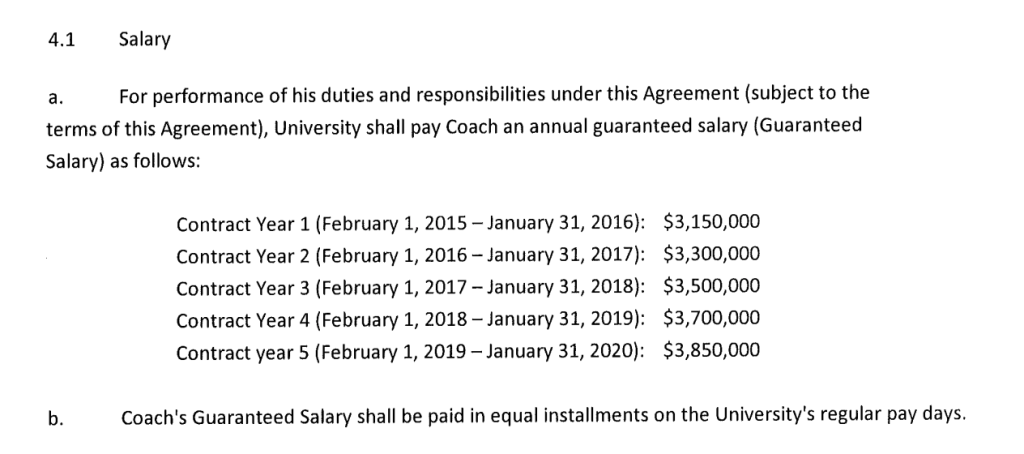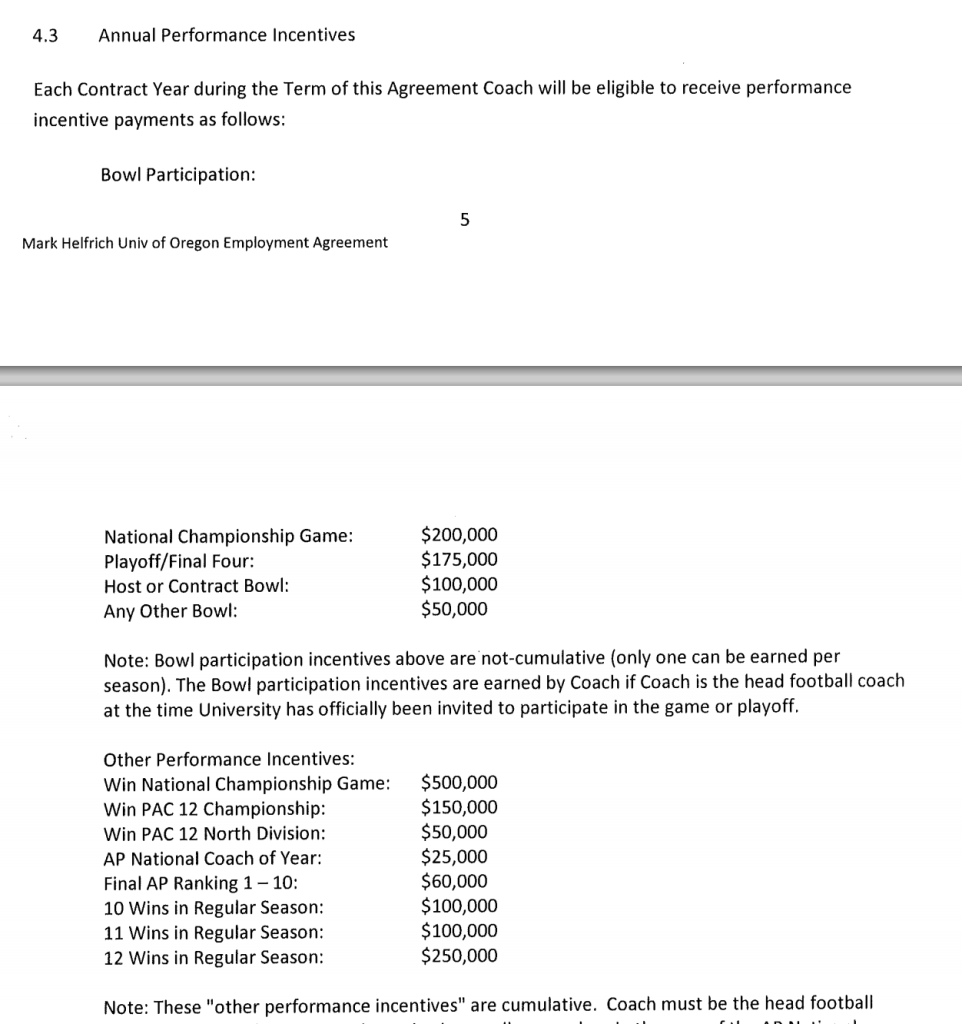Last updated on 11/08/2015
11/7/2015:
Apparently this win means the Ducks are going to some bowl game, and Helfrich gets a $50K bonus for that. Then we have to pay for all the admins and their families to go along for the junket. Here’s Tim Gleason, then Journalism Dean, now Faculty Athletics Representative, at the 2013 Fiesta Bowl student recruiting event:
VP for Enrollment Roger Thompson videotapes one or two humiliating events like this at every bowl game, so that the administrators can show the IRS there was a business purpose for their family’s holiday junket:

4/12/2015: Coach Helfrich’s raise totals more than all 1500 UO staff combined
UO has about 1500 staff workers, making an average wage of about $35,000 a year. Their SEIU local 503 is currently bargaining with OUS for a new contract. The OUS offer is an 0.5% COLA, or $175 each per year.
Meanwhile, the UO administration just found the money to give football coach Mark Helfrich a slightly larger raise:
Here’s the message from the SEIU local:
Higher Ed Management Proposals Not Unified Across State, Return to the “Big Three,” Attack Health Care, Steps, and More
We met for bargaining on Thursday and Friday, April 9th and 10th. This session ended on a very discouraging note. While we were hopeful of an early settlement, it is apparent that we will be digging in for a long and contentious fight for a fair and equitable settlement. (Click here for a full report.)
You may remember that management had proposed bargaining only pay, benefits, and other “financial” issues, this cycle. Our response was that we could agree, if we would have one “unified” economic package that was fair and equitable across all campuses. Management would not commit to this unified approach, and instead gave us two separate proposals, one to cover SOU, and the other covering the other six campuses. Both are the same, at this point – and equally bad, even for a beginning package: Our steps, health insurance, overtime pay, and much more is proposed to be reduced, and the proposed Cost of Living Increases are tiny, to boot. (Click here for details of the proposals.)
Our approach is centered on improving workers’ rights and benefits with proposals such as: protecting our staff fee privilege by rolling it into the contract; full health care coverage for part time employees; and pushing for University accountability for their administration-to-frontline employee staffing ratios; protecting tuition affordability for students; and ensuring a living wage is earned by all on campus, to name a few.
Management’s approach seems to be centered on a repeat of two years ago when they proposed a series of very drastic takeaways such as gutting our overtime computation, severely restricting our layoff rights, and making it easier to contract out our jobs. Yes, the same “BIG THREE” takeaways they proposed two years ago. (Click here for details.)
And, they are proposing changes to core finances of our jobs, such as to our health benefits (that would shift costs onto workers over time); to our steps (delaying/freezing them partially, yet again); and seeking to make it easier to contract out our jobs.
This session also included a fantastic membership meeting on Thursday where roughly 50 UO members had lunch with the bargaining team. They heard the update and had the opportunity to ask questions of the Team. We then marched and chanted around the library where the meeting took place. Then, on Friday, we saw selective presentations from members in several different classifications. (Click here for photos).
It is time to fight back! Please join your Local leaders and your Bargaining Delegate in visiting your FADM Vice President to demand a fair contract. A contract that is equitable and fair across all seven campuses. Click here to join in.
Register for our next Higher Ed Lobby Day (April 20). Travel to Salem to meet with your legislators to lobby for adequate funding for Higher Ed as well as their support for our Fair Shot campaign. Click here to register.
Upcoming bargaining sessions
- April 23rd and 24th at SOU
- May 7th and 8th at OSU Cascades in Bend
- May 28th and 29th at EOU
- June 7th and 8th location TBD




A better comparison would be how he fares in relation to other coaches of FBS teams consistently in the AP top 10, in conjunction with an in-depth study regarding the correlation to athletic revenue tied with athletic success. (ie if they were to hire a coaching making $100,000/year, would the revenue inevitably drop by a lower amount than the salary?) Without either of those, the way he is at best misinformed, and at worst, misleading.
Better to focus on how Athletics interacts with the Academic budget, rather than focusing on aspects of the Athletic budget that are universal to all athletically successful schools.
Only if you take it for granted that a top-ten football team is essential to UO’s mission. As for revenue, haven’t we already established that in terms of the balance sheet, athletics is a net loss?
I thought the main arguments for big-time sports was that it improved the “brand” and brought in donors, even though there is yet no solid evidence that either of these ultimately benefit the academic side.
Athletics is a net loss, but is football a net loss on its own?
His pay is on par with other coaches that have winning programs, no question about that. But I think it is worthwhile to highlight the difference in football salaries and raises to other employees of the university, because it is a system far out of whack with reality.
Helfrich makes $3M a year. The football program (according to http://www.forbes.com/sites/aliciajessop/2013/08/31/the-economics-of-college-football-a-look-at-the-top-25-teams-revenues-and-expenses/) made $30M in profit off of $50 million in revenue. So Helfrich makes 10% of profit and 6% of revenue.
What are some other standards of excess pay? People complain about non-profit CEOs that take too much of revenue, and that might be applicable since the U of O is a non-profit. I looked at http://www.huffingtonpost.com/2013/04/08/10-insanely-overpaid-nonp_n_3038162.html and the CEO of the American Cancer Society was near the top of the list, making $2.1 million. But the ACS has revenue of $971 million. So the “insanely overpaid” ACS CEO is paid 0.2% of revenue. Helfrich’s pay is scaled a whopping 30-fold higher on a revenue basis.
OK, but the ACS doesn’t have a “profit”, so maybe corporate CEO pay, notorious for being incredibly high, is a better comparison. This report (http://chiefexecutive.net/media-wrong-about-ceo-compensation) says, “for CEOs of private companies with revenue of between $250 million and $999.9 million … the top quartile compensation was $1,045,000—which means that almost three fourths of private company CEOs earned less than $1 million in 2010.”
So companies with revenues 5X-20X higher than Oregon football still pay CEOs less than $1M a year, except for the top quartile.
Football coaches must have some special reason to be paid so much. Job insecurity? I don’t know how insecure a job is when you get paid for the life of your contract even after being fired, and seiems at least as good as corporate CEOs. Is revenue sensitive to performance? A lot of the revenue comes from conference TV deals, which is independent of particular school performance. No, I think it is just a lack of commonsense and restraint, as schools are urged on by boosters to do anything and everything for a win. There are no shareholders to even mount a tepid resistance to this excess. Change has to be system-wide, which means rules about spending and compensation from the NCAA, which has little reason to do so.
A better comparison is of the football coach’s contribution to the University’s mission to the classified staff’s contribution to the University’s mission. To make that comparison I invite you to imagine the UO without the coach. Now try imagining the UO without the staff.
saw that Coltrane had the nerve to boldly claim that the administration was taking up less money out of the budget than our classified employees. Actually, it turns out, just one administrator salary would pay for the entire SEIU employee budget. I’m guessing he also conveniently forgot all the other expenses our administration is costing us, like the million dollar presidential buyout, or the million dollars in legal expenses. Thanks for that, Coltrane!
Is there any thought being given to the notion that there is a possibility that DF when in office developed and implemented a plan of a hostile takeover of the University to enrich a select few. Now I ask…is a plan to take over a public institution somewhat illegal? I mean…who benefits most from the blood sucking activities at the U by the administrative vultures…sure isn’t the students…its their blood…sure isn’t the Faculty…they are fighting to keep the U a U for education…and clearly isn’t the classified staff…they suffer with each breath the administration takes. So I ask the law profs is the take over of a public institution illegal????… 3 m+ to a football coach R U EFFING KIDDING?
What is the national average ratio for employees to managers? When will the blood suckers learn that there is more than enough for everyone? Stop being greedy and destroying our institution. Can we make a no confidence vote happen?
A budget is an expression of relative value and how we use our resources. The issue as raised is not whether Helfrich is paid fairly compared to his peers. The issue is the UO’s priorities and demonstration of tits values, through the budget allocation process. The UO APPEARS to be saying that Helfrich’s value, as expressed by his pay increase, is higher than the cumulative value of our staff that run this place (based on their recognition through pay increases). The football program does not exist in isolation from the University.